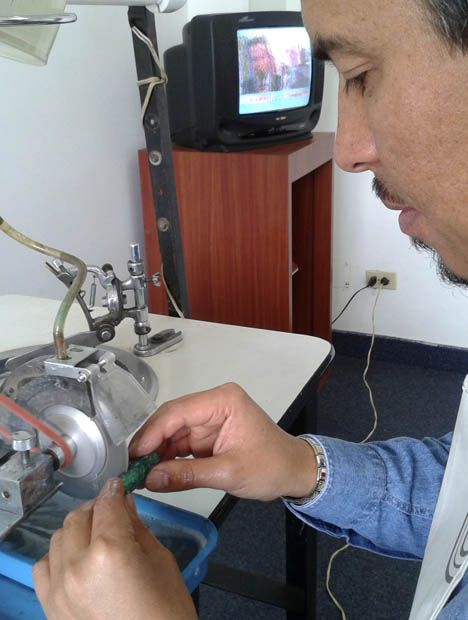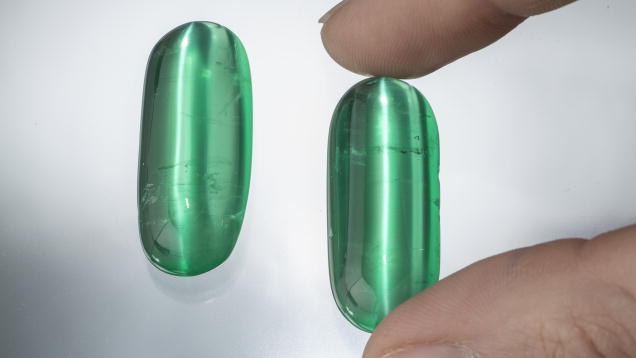Unveiling the Cat’s-Eye Effect in a 75 ct Colombian Emerald Pair
July 12, 2013

Once cleaned, this large trapiche emerald portion from Muzo weighed more than 300 ct. The rough revealed two major sections that might be suitable for cutting. All photos courtesy of Misael Angel Rodriguez.
Emerald Mystery Revealed in CuttingEmerald dealers are accustomed to speculation, because large pieces are inherently unknowable. Rodriguez’s dilemma was comparable to that of jadeite dealers in Myanmar (Burma), who often face similar anxieties when purchasing jadeite boulders. They are in effect betting on finding a valuable, deep color inside the stone—but not really knowing until they cut a window, or slice the boulder. For the sellers of such pieces there is also a gamble. More often than not, they too decline to cut windows into the rough for fear of losing weight, or perhaps cutting away the one valuable piece in an otherwise insignificant stone.
Rodriguez and wife Claudia Beltran Rubiano, both experienced emerald cutters, ultimately decided to take the gamble and purchase the rough. They cut one corner, and then another, attempting to judge the potential gem’s depth. They soon discovered that the chunk actually contained two portions of a six-ray trapiche emerald and concluded that two stones of similar size might be fashioned from it. They also noted a fine tube-like internal structure at one side of the rough, which is characteristic of the type of material that produces cat’s-eyes. As they further polished off the skin, they began to witness the unmistakable green of fine emerald.
“That is the riddle of emeralds in the rough,” Rodriguez explained. “Their splendor is often concealed.”

Next, Rodriguez trimmed excess pieces and sawed through the rough.
He and his wife started to slowly remove the carbonaceous outer layer of the emerald, while removing small holes and pits in the material. Bearing in mind that trapiche emeralds often yield cat’s eyes, and having noticed the fine tubes that give rise to the phenomenon, they placed small, curved facets into the rough, hoping to coax out a cat’s-eye effect. They soon found the eye’s strongest orientation, which gave them further guidance on how both gems would have to be cut.Both of the long cabochons began to take shape: Rodriguez, with his greater cutting experience, began fashioning what they considered the finer one. “But after each day of cutting and polishing, Claudia’s always looked better and finer than mine,” Rodriguez recalled.

Two emeralds were then pre-formed to achieve a nearly matched weight and color.
Once polished, the pair of emeralds weighed 105 carats total, which Rodriguez believes was a record weight for a matched pair. But sacrifices in weight still had to be made because of the inclusions, bringing the pair down to about 75 carats total. Rodriguez noted that gems of such size and quality, in a matched pair, had never been seen to date in Colombia.Shortly after the February 2013 Tucson gem show, GIA asked to see the stones, and they were sent to the Carlsbad laboratory for further examination.

Two large matching cat’s-eye emeralds, ultimately weighing close to 75 carats total, emerged from the rough trapiche. Photo by Robert Weldon, GIA.
GIA Laboratory ExaminationBoth stones were received at GIA in the spring of 2013. Their gemological properties were typical of cat’s-eye emeralds examined in the past. We recorded a spot RI of 1.57, chrome lines in the red portion of the spectrum, and no reaction to ultraviolet light.
What was really interesting about them was the internal structure that gave rise to the cat’s-eye effect. The dense parallel growth tubes appeared somewhat transparent, quite unlike the needles or growth tubes that cause the chatoyancy in many other cat’s-eye specimens. As noted, this type of structure in emerald is often found in the individual pie-shaped sections of trapiche emeralds. However, only rarely is it dense enough to cut a strong cat’s-eye, as was the case for the large matched pair we saw.
In his 1981 book Emeralds and Other Beryls, noted beryl connoisseur John Sinkankas wrote that cat’s-eye emeralds are so rare as to be practically nonexistent in the market. Since the book’s publication three decades ago, several Colombian cat’s-eye emeralds have been reported, and they are slightly more prevalent on the international market today. This is partly because emerald cutters are now looking at rough material with an understanding of when rare cat’s-eye emerald might be revealed, and also because collectors are actively seeking out these stones for their rarity and beauty.



